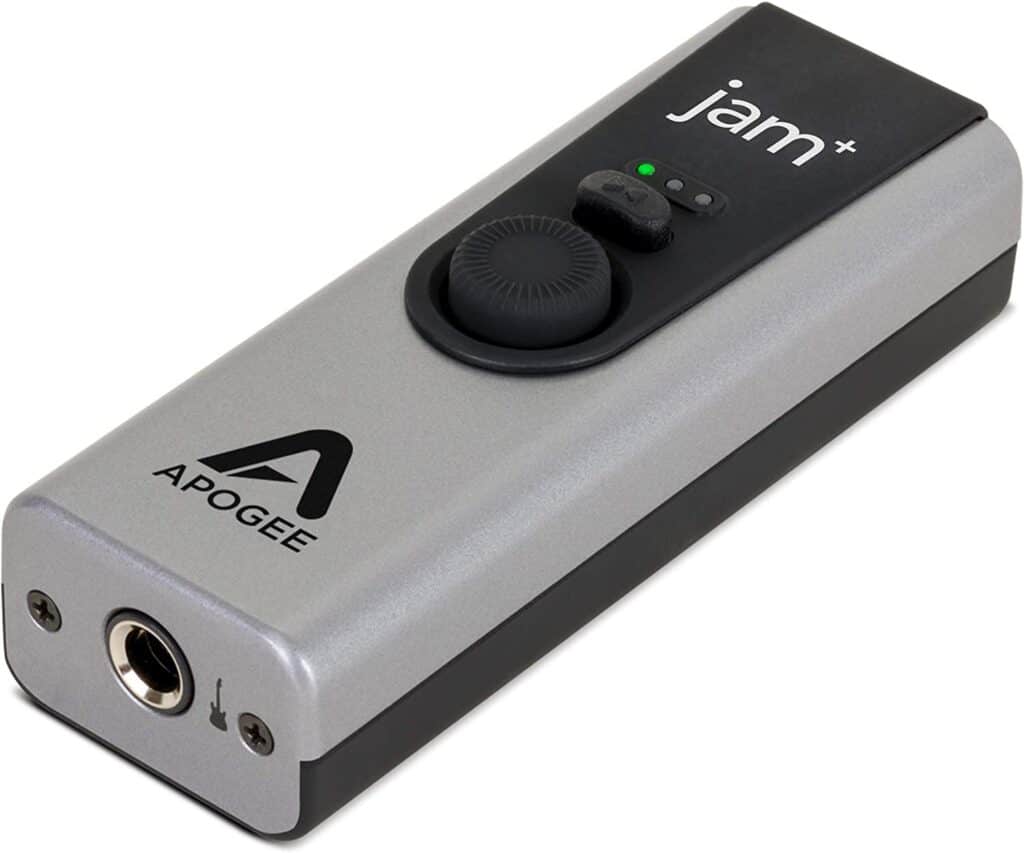Apogee markets its guitar interface for the iPad, the Jam, as “the missing link in your portable studio”. For intermediate recording guitarists, that may be true. But for the rest of us hobbyists, Apogee Jam is just a user-friendly, highly portable device that gives impressive sound at a wildly affordable price.
I’ve spent about a month toying with my Jam, which I use to connect a Fender American Stratocaster to my Apple iPad Air running Garage Band. Apogee Jam isn’t for everyone, but this review will help you figure out if the interface, which retails for about $170, is right for you.

Below are the pros, the cons, and the bottom line for Apogee’s iPad guitar interface, the Jam.
Table of Contents
The Pros: Easy Set-up, Flexibility, Impressive Sound
Easy Set-up
Apogee markets the Jam with the phrase “plug in, play, record”, and in my experience, it’s just that easy. Within 10 minutes of opening the box, I had the Jam unit attached to my iPad and was playing through Garage Band’s nice assortment of simulated amplifiers. The Jam comes with two interface cables, one to connect your guitar to the iPad, and one that can connect your guitar to a USB port on a Mac notebook or desktop computer.
The unit is literally plug-and-play, with just one small glitch. The included instructions (a small one-page insert in the packaging) fail to mention that to make the guitar signal go live, there’s a button in the top left of the Garage Band screen that the user must push. Even so, Garage Band is easy to use and has a nice help function, so this was no barrier to playing through my iPad within minutes of opening the box.
Flexibility
Probably the most impressive feature of the Jam is its tonal flexibility. I have been surprised by the wide range of sounds I can produce using Garage Band’s array of simulated amplifiers. Each of which offers its own controls for gain, range, tone, reverb, and level. But the onboard effects pedals, which include a nice set of distortions and overdrives, a surprisingly bright chorus, and some nice specialties (auto-funk comes to mind), really add to the Jam’s power as a tool for songwriting and imitation. I can’t think of a major stylistic sound that can’t be imitated using the Jam and Garage Band. Anything from rock, metal, jazz, blues, funk, surf, and soul. They’re all easily set up by choosing your amp and stompbox assembly.
Sound
Apogee exaggerates when it terms the Jam’s sound as “studio-quality”, but it’s not far off. Apogee’s other marketing slogan for the Jam, “superior sound quality” comes closer to the mark. I don’t expect to hook up to the Jam the next time I’m in a professional studio. But for a unit that retails for under $200, the sound quality of the Jam definitely qualifies as “superior”. Once you adjust the input level properly, the guitar signal experiences minimal unwanted distortion. The Jam’s signal processing results in shimmering chorus effects, tight crunch, and reverbs and compressors that let your playing soar. You can also arrange the order of the stomp boxes so you can tailor the processing of the signal for your own favorite tones.
Cons: Lack of Precision, Input Leveling
Lack of Precision
My one main complaint about the Jam is that despite its tonal flexibility, adjusting the sound precisely is difficult if not impossible. The simulated amplifiers in Garage Band have plenty of knobs that users control via the iPad’s touch screen. But these knobs can be difficult to control precisely, and for users used to analog controls on real-world amplifiers, this will be a major annoyance. An input box that allows users to enter settings manually would fix this problem. But for now, users will have to deal with the frustration of trying to position the knobs via touch. This is not in any way Apogee’s fault, but still some you should be aware of if you plan to use the Jam Plus.
Input Leveling
Another problem with the Jam is the difficulty of adjusting the input level to avoid clipping. The simple LED light clearly shows when clipping occurs, but the dial that sets the input level is not marked with numbers or defined settings. As a result, each time a user connects a guitar, time must be spent adjusting the signal level. For users who typically play through the same guitar set-up, a numbered dial would make this process much more efficient.
The Bottom Line: Cheap, Easy, Impressive
Overall, the Jam is an excellent value for the intermediate-level guitarist who wants portability and ease of recording. The Jam exceeds my expectations, enough so that I’m selling one of my main amplifiers. I sell it because I don’t play through it enough to justify keeping it. I was getting value from my iPad before I bought the Jam. But now that I play primarily through the Jam, the iPad is a real multi-function value for me.
Conclusion
Apogee’s Jam Plus is more than just great for its price – it’s great, period. It’s not the best way to record your guitar, but I find myself using it more and more because it really is the simplest way of recording a guitar.
If you’re just starting out and don’t want to commit to a recording rig that costs thousands of dollars or just looking for a quick plug-and-play solution for guitar recordings, look no further.
I have the Jam+ and I got to say that your review is spot on. It’s not the best way to record a guitar, but it’s a great way to record your ideas fast and make rough versions of songs.